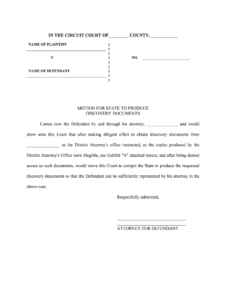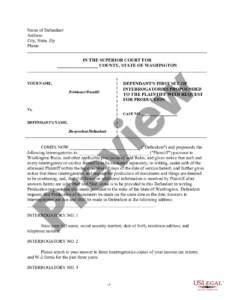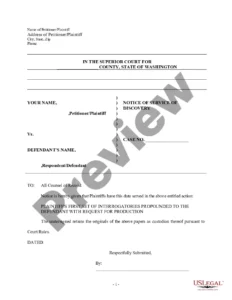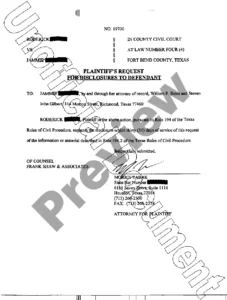Utilizing such a structured document offers several key advantages. It empowers individuals to build a stronger defense by allowing them to review the prosecution’s case, potentially revealing weaknesses or inconsistencies. Access to this information can facilitate informed decisions regarding plea bargains or proceeding to trial. Moreover, it levels the playing field, ensuring individuals have the necessary tools to navigate the legal system effectively. Ultimately, this process contributes to a more just and equitable outcome.
The following sections will delve deeper into the specific components of such a request, offering practical guidance on its creation and utilization. Topics covered will include the legal basis for such requests, the types of information typically sought, and best practices for submitting and managing the process.
Key Components of a Discovery Request for Traffic Violations
Effective discovery requests in traffic violation cases require specific components to ensure clarity, completeness, and legal validity. These components work together to facilitate the efficient exchange of information between the defendant and the prosecution.
1. Case Information: Accurate identification of the case is paramount. This includes the citation number, court jurisdiction, date of the alleged offense, and the defendant’s name and contact information. Clear case identification prevents confusion and ensures the request is directed to the correct authorities.
2. Specific Requests: Precisely articulated requests for evidence are essential. Ambiguity can lead to delays or incomplete disclosure. Examples include requests for the officer’s notes, dashcam footage, witness statements, calibration records for speed detection devices, and the arresting officer’s training certifications.
3. Legal Basis: Citing the relevant legal rules or statutes governing discovery in traffic cases strengthens the request and reinforces its legitimacy. This demonstrates an understanding of the legal framework supporting the right to access this information.
4. Deadline: Including a reasonable timeframe for the prosecution to respond ensures timely access to the requested information. This allows adequate time to review the evidence and prepare a defense.
5. Contact Information for Response: Providing clear contact information, such as an email address or mailing address, facilitates efficient communication and ensures prompt receipt of the disclosed evidence.
6. Signature and Date: Formalizing the request with a signature and date affirms the authenticity and seriousness of the request.
A well-drafted request provides a structured framework for obtaining necessary evidence, enabling a thorough defense preparation and promoting transparency within the legal process. This meticulous approach contributes significantly to a fair and informed resolution of traffic violation cases.
How to Create a Request for Discovery in Traffic Violation Cases
Creating a comprehensive discovery request is essential for effectively preparing a defense in traffic violation cases. A well-structured request ensures access to all relevant evidence held by the prosecution, promoting transparency and facilitating a fair legal process. The following steps outline the process of creating such a request.
1. Obtain a Template: Utilizing a template can streamline the process and ensure all necessary components are included. Templates are often available online or through legal aid organizations. Adapting a template to the specific circumstances of the case ensures relevance and clarity.
2. Identify the Case Accurately: Precise case identification is crucial. This requires accurate inclusion of the citation number, the court’s jurisdiction, the date of the alleged offense, and the defendant’s full name and current contact information. Errors in this section can lead to delays or misdirection of the request.
3. Formulate Specific Requests: Clearly articulate the specific evidence sought. Vague requests may result in incomplete disclosure. Examples include the police report, dashcam or bodycam recordings, witness statements, photographs, and calibration logs for any devices used in the citation, such as radar guns or breathalyzers.
4. Cite Legal Authority: Referencing the applicable rules of procedure or statutes governing discovery in traffic cases strengthens the request and asserts its legal basis. This demonstrates an understanding of the legal framework supporting the right to access this information.
5. Establish a Reasonable Deadline: Including a realistic timeframe for the prosecutions response ensures timely receipt of the requested materials. This allows adequate time to review the disclosed evidence and prepare a robust defense.
6. Provide Contact Information: Clear contact information, including a mailing address, email address, and phone number, facilitates efficient communication with the prosecution and ensures prompt delivery of the disclosed materials.
7. Review and Finalize: Thoroughly review the completed request for accuracy and completeness before submission. Ensuring all necessary information is included and accurately presented avoids potential delays and facilitates a smoother process.
8. Submit the Request: Submit the finalized request to the appropriate court or prosecutorial office according to established procedures. Retaining a copy of the submitted request for personal records is recommended.
Careful preparation of a discovery request is a crucial step in navigating traffic violation cases. A comprehensive and well-structured request allows individuals to understand the evidence against them, prepare a more effective defense, and contribute to a more transparent and equitable legal proceeding.
Access to information is paramount in ensuring fairness and due process within the legal system. Utilizing a structured approach, as exemplified by a pre-designed document for seeking evidence related to traffic citations, provides individuals with a crucial tool to navigate legal proceedings effectively. Understanding the components of such a request, including accurate case identification, specific requests for evidence, and adherence to legal procedures, empowers individuals to engage more effectively with the legal process. This process fosters transparency by enabling access to the prosecution’s case, allowing for a more informed defense strategy and promoting a more equitable outcome.
Engaging proactively with the legal system, through informed utilization of available resources, is crucial for upholding individual rights and ensuring a fair and just legal process. The ability to obtain and analyze relevant evidence contributes significantly to a more balanced and equitable legal landscape, ultimately fostering greater trust and transparency within the justice system.



